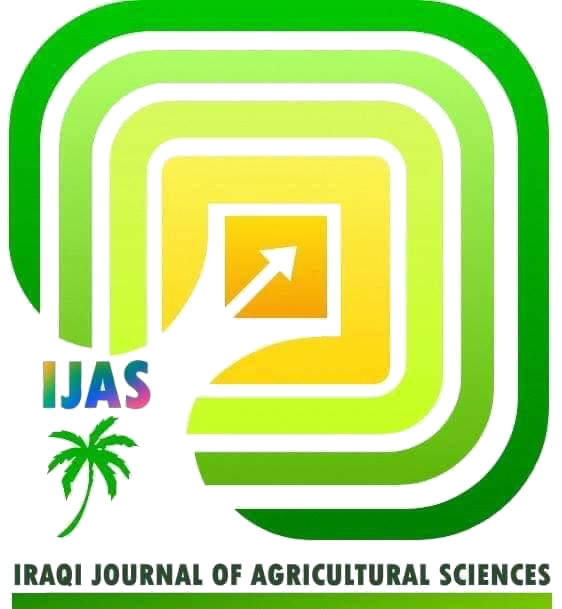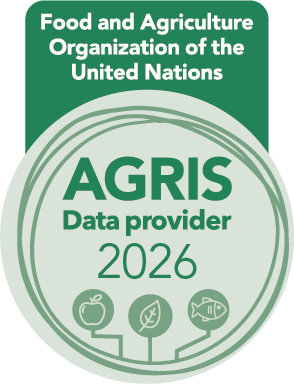EVALUATING PRACTICAL VS. THEORETICAL WATER CONSUMPTION IN MODIFIED AIR COOLERS
DOI:
https://doi.org/10.36103/w3622796Keywords:
evaporative cooling, Temperature reeducation, increase water flow, cooling, sustainable solutionAbstract
This study aimed to investigate the impact of increased water flow and two different air speeds on water consumption and cooling performance in modify air coolers. An experiment was conducted using an air cooler with an additional water pump to facilitate increased water flow. One Way ANOVA with regression and Tukey was used. Findings revealed that practical water consumption significantly surpassed theoretical estimates, primarily due to heightened resistance encountered by water as it traversed the cooling pads. Notably, the implementation of two water pumps improved cooling, effectively lowering room temperature by7-10 °C (Δt of 9.4°C); however, this enhancement was accompanied by increased power consumption. Statistical analysis showed significant differences in practical water consumption between different treatment groups (Q1S2-Q1S1,Q1S2-Q2S2,Q1S2-Q2S2,Q2S2-Q1S2, Q2S1-Q1S2)(P<0.0003). This research underscores the critical need for effective water management strategies within evaporative cooling systems, particularly in arid regions where water scarcity is a pressing concern. Future research should explore sustainable energy solutions to optimize both water and energy use.
References
1.Ahmadu, T. O., Y. S. Sanusi, and F. Usman, 2022. Experimental evaluation of a modifed direct evaporative cooling system combining lufa fber—charcoal cooling pad and activated carbon dehumidifying pad. Journal of Engineering and Applied Science, 69:63, 1-18. https://doi.org/10.1186/s44147-022-00116-1
2.Ahmed, A. K., and N. S. Kadhim, 2024. Analysis of the Performance of a Coolling System (Refrigerator) Operating with a Thermoelectric Cooling System Used to Preserve Crops and Agricultural Products. Iraqi Journal of Agricultural Sciences, 55(5), 1766-1773. https://doi.org/10.36103/sntyqs48
3.Al-Badri, S. B., and M. Abdul-Abass, 2014. Determination the Heat Performance for the Evaporative Cooling Pads. Ama, Agricultural Mechanization in Asia, Africa and Latin America, 45(2).
4.Al-Badri, S. B., and F. F. Al-Makhual, 2016. Study the Effect of Add Secondary Water Pump to Air Cooler type Bf3 on the Efficiency of Air. Elixir International Journal, 96, 41211-41213 .
5.Al-Hajani, M. A., N. N. Haded, and S. F. Al Bamarny, 2022 . Influence of Citric Acid, GINGER Extract and Storage on Fruit Quailty of Local Orange ( Citric sinensis L. Osbeck). Iraqi Journal of Agricultural Sciences, 53(4), 850-856. https://doi.org/10.36103/ijas.v53i4.1597
6.Al-Helal, I. M., N. Al-Abbadi, and A. Al-Ibrahim, 2024. Astudy of Fan-Pad Performacne for a Photovoltaic Powere Greenhoues in Saudi Arabian Summer. International Agricultural Engineering Journal, 13(4), 113-124.
7.Al-Helal, I. M.-T. 2001. Evaporative cooling for palm dates fiber pads and cross-fluted cellulose pads under arid conditions. Misr Journal of Agricultural Engineering, 18, 469-483.
8.Ali, H. W., and A. M. Aljabary, 2023. Maintenance of pomegranate fruit quality by coating with flaxseed, black seed oils, and chitosan during different storage periods. Iraqi Journal of Agricultural Sciences, 54(6), 1689-1702. https://doi.org/10.36103/ijas.v54i6.1868
9.Ali, M., W. Ahmed, N. A. Sheikh, H. Ali, R. Kousar, and T. Rashid, 2021. Performance enhancement of a cross flow dew point indirect evaporative cooler with circular finned channel geometry. Journal of Building Engineering, 35, 1-13. https://doi.org/10.1016/j.jobe.2020.101980
10.Ali, M., W. Ahmed, N. Sheikh, H., Ali, and T. Rashid, 2021. Performance enhancement of a cross flow dew point indirect evaporative cooler with circular finned channel geometry. Journal of Building Engineering, 35, 1-13.https://doi.org/10.1016/j.jobe.2020.101980
12.Alodan, M. A. F. 2005. Design and Evaluation of Galvanized Metal Sheets as Evaporative Cooling Pads. Journal of King Saud University, 18(1), 9-18.
13.Al-Suliman, F. 2001. Evaluation of the Performance of Local Fibers in Evaporative Cooling. Energy Conversion and Management,, 34(2002), 2267-2273. https://doi.org/10.1016/S0196-8904(01)00121-2
14.Al-Yasari, M. S., and S. B. AL-Badri, 2024. Using Evaporative Cooling and Packaging to Store Eggplant Crops. Anbar Journal of Agricultural Sciences, 22(2), 1581-1593. https://doi.org/10.32649/ajas.2024.141807.1363
15.ASHRAE. 1983. Fundamentals Handbook. New Yourk: American Society of Heating, Refrigerating , and Air Conditioning Engineers.
16.ASHRAE. 1992. Evaporative air cooling, ch19.In1992 HVAC systems and Equipment handbook. Atlanta GA: Am.soc. of Heating, Refrigerating, and Air-conditioning Engineers,Inc.
17.Bucklin, R., D. Leary, and E. Wilkerson, 1993. Fan and Pad Greenhouse Evaporative Cooling Systems. Institute of Food and Agricultural Sciences, University of Florida, 1-7.
18.Czarick, M. 2001. Black Evaporative Cooling Pads and Fans. Poultry Housing Tips, 13(10), 1-4.
19.Czarick, M., B. Fairchild, and S. Watkins, 2009. The Importance of Flushing Evaporative Cooling Systems. Poultry Housing Tip, 21(8), 1-4.
20.Fao. 2017. Water for Sustainable Food and. Rome: Food and Agriculture Organization of the United Nations. doi:10.1007/s13280-016-0793-6
21.Ghoname, M. S. 2020. Effect of Pad Water Flow Rate on Evaporative Cooling System Efficiency in Laying Hen Housing. Journal of Agricultural Engineering, LI:1051, 209-219. https://doi.org/10.4081/jae.2020.1051
22.Haile, M., R. Garay-Martinez, and A. M. Macarulla, 2024. Review of Evaporative Cooling Systems for Buildings in Hot and Dry Climates. Buildings, 14, 1-21. https://doi.org/10.3390/buildings14113504
23.Hasan , M., and A. Bashiri, 2024. A Novel Approach Development to Control Solar Air Cooler Using Intelligent Technique. International Journal of Mathematical, Engineering and Management Sciences, 9(4), 821-834. https://doi.org/10.33889/IJMEMS.2024.9.4.042
24.Hery, S., Evi, S., and R. Arief, 2022. Assessment of direct evaporative cooler performance with a cooling pad made from banana midrib and ramie fiber. Smart and Sustainable Built Environment, 11(3), 469 - 482. https://doi.org/10.1108/SASBE-06-2020-0078
25.Joseph , M., and J. Zulovich, 2009. Maintenance of Evaporative Cooling Systems. University of Missouri , 1-3.
26.Kachhwaha, S., and S. Prabhakar, 2010. Heat and mass transfer study in a direct evaporative cooler. Journal of Scientific and Industrial Research, 69, 705-710.
27.Karpiscak, M., and M. H. Marion, 1994. Evaporative cooler water use. The University of Arizona • College of Agriculture , 1-7.
28.Karpisck, M., and M. Marion, 1994. Evaporative Cooler Water Use. The University of Arizona • College of Agriculture Tucson, Arizona 85721. Retrieved from http://ag.arizona.edu/pubs/
29.Ketwong, W., T. Deethayat, and T. Kiatsiriroat, 2021. Performance enhancement of air conditioner in hot climate by condenser cooling with cool air generated by direct evaporative cooling. Case Studies in Thermal Engineering, 1-12. https://doi.org/10.1016/j.csite.2021.101127
30.Laknizi, A., M. Mahdaoui, A. Abdellah, K. Anoune, M. Bakhouya, and H. Ezbakhe, 2018. Performance analysis and optimal parameters of a direct evaporative pad cooling system under the climate conditions of Morocco. Thermal Engineering, 1-11. doi:https://doi.org/10.1016/j.csite.2018.11.013
31.Lossow, T. V. 2018. More than infrastructures:water challenges in Iraq. Netherlands: Clingendel.
32.Mussa, M. A., I. M. Aljubury, and W. S. Sarsam, 2024. Experimental and analytical study of the energy and exergy performance for different evaporative pads in hot and dry climate. Results in Engineering, 21, 1-9. https://doi.org/10.1016/j.rineng.2023.101696
33.Nada, S., H. Elattar, M. Mahmoud, and A. Fouda, 2020. Performance enhancement and heat and mass transfer characteristics of direct evaporative building free cooling using corrugated cellulose papers. Energy, 211, 1-17. https://doi.org/10.1016/j.energy.2020.118678
34.Purswell, J., J. Linhoss, C. Edge, J. Davis, and J. Campbell, 2018. Water Supply Rates For Recirculating Evaporative Cooling Systems. American Society of Agricultural and Biological Engineers, 34(3), 581-590. https://doi.org/10.13031/aea.12652
35.Rathnayaka, K., H. Malano, S. Maheepala, B. George, B. Nawarathna, M. Arora, and P. Roberts, 2015. Seasonal Demand Dynamics of Residential Water End-Uses. Water, 203-216. https://doi.org/10.3390/w7010202
36.Rawangkul, R. K. 2008. Performance analysis of a new sustainable evaporative cooling pad made from coconut coir. International Journal of Sustainable Engineering, 1(2), 117-131. https://doi.org/10.1080/19397030802326726
37.Rong, L., P. Pedersen, T. L. Jensen, S. Morsing, and Z. Guoqiang, 2017. Dynamic performance of an evaporative cooling pad investigated in a wind tunnel for application in hot and arid climate. Biosystems Engineering, 173-182. https://doi.org/10.1016/j.biosystemseng.2017.02.003
38.Salaudeen, K. O. 2013. Effect of NSPRI tin-in-pot compared with pot-in-pot evaporative cooler on the stored fruits. International Journal of Engineering and Technology, 2(1), 63-69. https://doi.org/10.14419/ijet.v2i1.573
39.Shahzad, K., M. Sultan, M. Bilal, H. Ashraf, M. Farooq, T. Miyazaki, and M. I. Hussain, 2021. Experiments on Energy-Efficient Evaporative Cooling Systems for Poultry Farm Application in Multan (Pakistan). Sustainability, 13(5), 1-21. https://doi.org/10.3390/su13052836
40.Simmons, J. D. 1996. Evaporative cooling performance resulting from changes in water temperature. Applied engineering in agriculture (USA), 12(4), 497-500. https://doi.org/10.13031/2013.25676
41.Sulaiman, M. A., A. M. Adham, H. F. Hassan, A. C. Benim, and H. A. Anjal, 2024. Performance analysis of novel dew point evaporative cooler with shell and tube design through different air-water flow configurations. Energy, 289, 1-14. https://doi.org/10.1016/j.energy.2023.129922
https://doi:https://doi.org/10.1016/j.energy.2023.129922
42. Wang, B., Z. Chen, G. You, J. Ding, G. Cheng, and T. Bui, 2024. Improving indoor air quality and cooling efficiency: Indirect. Energy and Buildings,324,1-12. https://doi.org/10.1016/j.enbuild.2024.114908
Downloads
Published
Issue
Section
License
Copyright (c) 2025 IRAQI JOURNAL OF AGRICULTURAL SCIENCES

This work is licensed under a Creative Commons Attribution-NonCommercial 4.0 International License.

2.jpg)


